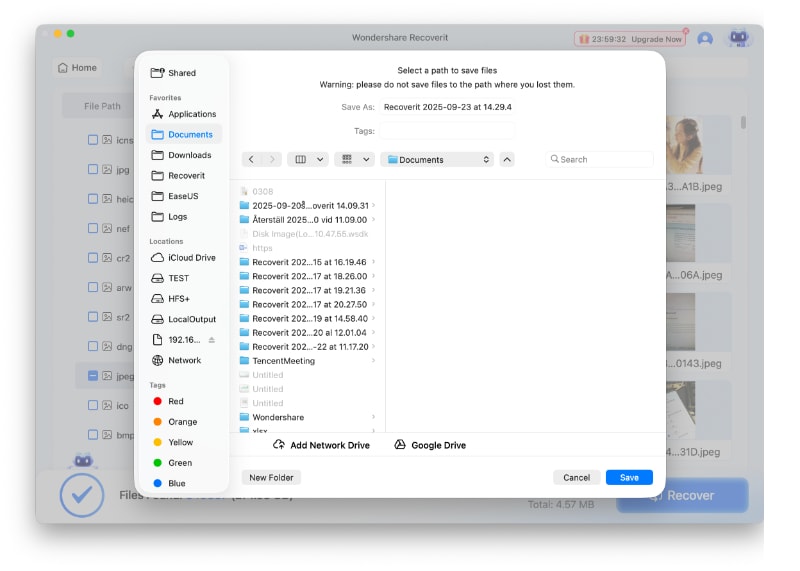"Hello, I'm trying to export my video project from iMovie, but I keep getting this frustrating error message: 'iMovie Error! Video Rendering error 10008.' I've spent hours working on this project, and now I can't even save it. Has anyone else encountered this issue? How can I fix the iMovie export failed video rendering error 10008?"
If you've found yourself in a similar situation, searching online forums for a solution to the frustrating iMovie export video rendering error 10008, you're not alone. This common yet perplexing error has left many Mac users confused. But don't worry – we're here to help you navigate through this technical hiccup and get your iMovie masterpiece ready!
Try Wondershare Recoverit to Perform Data Recovery

In this article
Part 1: Overview of iMovie Export Failed Video Rendering Error 10008
The iMovie export failed video rendering error 10008 is a frustrating issue that occurs when users attempt to export their video projects from iMovie. This error typically occurs during the rendering process, preventing the successful completion of the export. When encountering this error, users are often left with an incomplete or corrupted video file, unable to share their work or save it in a usable format.
The error message "iMovie Error! Video Rendering error 10008" can be particularly alarming, especially for those who have invested significant time and effort into their projects.
Part 2: What Causes the iMovie Export Failed Video Rendering Error 10008?
Understanding the root causes of the iMovie export video rendering error 10008 is crucial for effectively addressing and preventing the issue. Here are some common factors that may contribute to this error:
- Insufficient storage space on your Mac
- Outdated versions of iMovie or macOS
- Corrupted video files or frames within the project
- Changes in the location of imported video files
- Incompatible video formats or codecs
- High-resolution videos that exceed iMovie's processing capabilities
- Conflicting third-party plugins or extensions
- Temporary software glitches or conflicts within iMovie
- Fragmented or corrupted iMovie project files
- System resource limitations, such as low memory or CPU overload
Part 3: How to Fix the iMovie Export Video Rendering Error 10008?
Now that we've identified potential causes, let's dive into the solutions. We'll explore various methods to fix the how to fix rendering error 10008 on iMovie, explaining why each fix works and providing step-by-step instructions.
Fix 1: Keep the Imported Video Location Same
iMovie relies on the original file locations of imported videos. If these locations change, it can lead to rendering errors.
Steps:
Step 1: Open Finder and navigate to the folder where your original video files are stored. Ensure that all video files used in your iMovie project are still in their original locations.

Step 2: If any files have been moved, return them to their original folders. Reopen iMovie and try exporting your project again.
By maintaining consistent file locations, you reduce the risk of iMovie encountering the export failed video rendering error 10008 due to missing or relocated files.
Fix 2: Use the Latest Version of iMovie and macOS
Software updates often include bug fixes and improvements that can resolve rendering issues.
Steps:
Step 1: Click on the Apple menu and select "About This Mac". Click on "Software Update" to check for available updates. If updates are available for macOS, download and install them.

Step 2: Open the App Store and search for iMovie. If an update is available, click "Update" next to iMovie. Once all updates are installed, restart your Mac. Open iMovie and attempt to export your project again.

Keeping your software up-to-date ensures you have the latest fixes for known issues, potentially resolving the iMovie export video rendering error 10008.
Fix 3: Free up Storage Space on Mac
Insufficient storage can cause rendering errors as iMovie needs space to process and save exported files.
Steps:
Step 1: Click on the Apple menu and select "About This Mac". Go to the "Storage" tab to see available disk space. If space is low, click on "Manage" to open Storage Management.

Step 2: Review the recommendations and remove unnecessary files. Empty the Trash to free up additional space. Aim to have at least 10-15% of your total disk space free.

Step 3: Restart iMovie and try exporting your project again.
By ensuring ample free space, you provide iMovie with the necessary resources to complete the rendering process without encountering the export failed video rendering error 10008.
Fix 4: Create a Duplicate of iMovie Project
Sometimes, project files can become corrupted. Creating a duplicate allows you to work with a fresh copy.
Steps:
Step 1: In iMovie, select your problematic project. Go to the folder location of the iMovie project file, right-click on it and select "Duplicate Project." Give the duplicate a new name.

Step 2: Open the duplicated project. Attempt to export the video from this new project.
Working with a duplicate project can help bypass any corruption in the original file, potentially resolving the iMovie export video rendering error 10008.
Fix 5: Reduce Video Resolution Before Rendering
High-resolution videos can strain iMovie's processing capabilities, leading to rendering errors.
Steps:
Step 1: Open your iMovie project. Select the problematic high-resolution clip(s). Go to "Modify" > "Scale" in the menu bar. Reduce the scale to 50% or 75%.

Step 2: Alternatively, go to "File" > "Project Properties". Change the resolution to a lower setting (e.g., 720p instead of 1080p). Try exporting the project again.

By reducing the resolution, you lighten the processing load on iMovie, which can help avoid the how to fix rendering error 10008 on iMovie issue.
Fix 6: Remove Corrupted Frames
Corrupted frames within your video can cause rendering errors.
Steps:
Step 1: Review your iMovie project timeline carefully. Look for any glitchy or distorted frames. Select these problematic sections. Press the "Delete" key to remove them.

Step 2: If necessary, use transitions to smoothly connect the remaining footage. Attempt to export your project again.
Eliminating corrupted frames can prevent them from interfering with the rendering process, potentially resolving the iMovie export failed video rendering error 10008.
Part 4: Recover Lost/Deleted iMovie Project Files Easily: Use Recoverit
In some cases, you might accidentally delete your iMovie project while trying to fix the rendering error. Don't panic! You can use a data recovery tool like Recoverit to retrieve your lost files.
Why Recoverit works: It's designed to recover various file types, including iMovie projects, from different storage devices.
Steps to use Recoverit:
Step 1: Install Recoverit on your Mac. Launch the application and select the drive where your iMovie project was stored. Click "Start".

Step 2: Recoverit will now begin scanning the selected macOS drive to look for deleted iMovie files.

Step 3: Once the scan is complete, preview the recoverable files. Select your iMovie project files and click "Recover." Choose a safe location to save the recovered files.

Using Recoverit can be a lifesaver when dealing with lost or deleted iMovie projects, especially when troubleshooting the iMovie export video rendering error 1008.
Part 5: Tips to Avoid Common iMovie Errors on Mac
Here are some tips to help you avoid encountering the iMovie export failed video rendering error 10008 and other common issues:
- Regularly update iMovie and macOS to ensure you have the latest bug fixes and improvements.
- Maintain sufficient free storage space on your Mac. Aim for at least 15-20% free space at all times.
- Use a consistent file organization system for your video projects. Keep all source files in a dedicated folder to prevent relocation issues.
- Before starting a new project, check that your Mac meets iMovie's system requirements, especially for high-resolution or 4K video editing.
- Regularly create backups of your iMovie projects using Time Machine or other backup solutions.
- When importing videos, consider optimizing them for iMovie by converting them to a compatible format like MP4 with H.264 encoding.
- Avoid using beta or preview versions of iMovie for important projects, as they may contain bugs or instabilities.
- Close unnecessary applications while working in iMovie to free up system resources.
- Periodically clear iMovie's cache and preferences if you encounter persistent issues.
- Consider breaking very large projects into smaller, more manageable segments to reduce the strain on iMovie during rendering.
By following these tips, you can significantly reduce the likelihood of encountering the how to fix rendering error 10008 on iMovie and other common iMovie errors, ensuring a smoother video editing experience on your Mac.
Conclusion
The iMovie export failed video rendering error 10008 can be a frustrating obstacle in your video editing journey. However, armed with the knowledge and solutions provided in this guide, you're now well-equipped to tackle this iMovie error 10008.
If you find yourself facing the iMovie export video rendering error 1008 in the future, don't panic. Work through the fixes we've outlined, starting with the simplest solutions like checking file locations and freeing up storage space, before moving on to more involved methods like reducing video resolution or recovering lost files.
Try Wondershare Recoverit to Perform Data Recovery

FAQ
-
Can the iMovie export failed video rendering error 10008 cause permanent loss of my project?
While the error itself doesn't typically cause permanent loss, it can prevent you from exporting your project. However, your original project should remain intact within iMovie. If you're concerned about losing your work, it's always a good idea to regularly save backups of your projects. In the rare case that your project becomes corrupted or accidentally deleted while troubleshooting, you can use data recovery tools like Recoverit to retrieve lost files. -
How often should I update iMovie to avoid the iMovie export video rendering error 1008?
It's recommended to keep iMovie updated to the latest version available for your macOS. Apple typically releases updates to address bugs and improve performance. Check for updates at least once a month, or enable automatic updates in the App Store preferences. However, if you're in the middle of an important project, it might be wise to wait until you've completed and exported your work before updating, unless the update specifically addresses rendering issues. -
Can using external hard drives for storing project files contribute to the how to fix rendering error 10008 on iMovie issue?
While using external hard drives for storing project files is generally fine, it can potentially contribute to rendering errors if not managed properly. The most common issue arises when the external drive is disconnected or its location changes, causing iMovie to lose track of the source files. To minimize this risk, always ensure your external drive is properly connected before opening iMovie, use a consistent file structure, and consider using a dedicated external drive for your video projects. Additionally, using a fast, reliable external drive (preferably SSD) can help prevent performance-related rendering issues.




 ChatGPT
ChatGPT
 Perplexity
Perplexity
 Google AI Mode
Google AI Mode
 Grok
Grok























